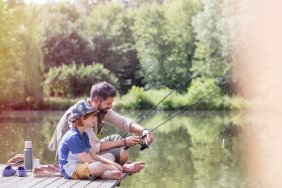 So now that you’ve read about what lures work well for bass in the fall and picked up a few of them at your local retailer, it’s time to learn where and how to use them in order to pull a few bucketmouths to the boat. Knowing where to find fish without having to resort to trial and error or electronics is a good skill to possess on the water and all it takes is a little knowledge on how bass alter their habits this time of year.
So now that you’ve read about what lures work well for bass in the fall and picked up a few of them at your local retailer, it’s time to learn where and how to use them in order to pull a few bucketmouths to the boat. Knowing where to find fish without having to resort to trial and error or electronics is a good skill to possess on the water and all it takes is a little knowledge on how bass alter their habits this time of year.
Bass can feel the winter coming and as a result, are actively feeding in order to fatten themselves up this fall. Their prey item of choice usually consists of whatever natural baitfish are present in a given body of water. Whether it’s shad, bluegill, or minnows, you should do your best to match such prey this time of year, in order to give the most desirable and natural presentation.
There are two main types of locations where any angler should begin their search for bass this fall: green vegetation and drop-offs where the shallow water near shore breaks off into deeper water. During fall, vegetation begins to die off, so bass will seek, and congregate near, any available green plants that still remain in an attempt to take advantage of the oxygen such vegetation still produces. Most of this vegetation will be found in the deeper water a little further from shore. Bass will also hold in these deep drop-offs and venture into the shallows frequently to forage for food.
Cold fronts always have an effect on bass activity, but as fall progresses and cold fronts become more prevalent, the changes in fish behavior will be more extreme. Cold fronts during early fall tend to simply cause bass to become active later in the afternoon, when it’s warmer. However, as the temperatures remain consistently cool and the cold fronts become, well, colder, anglers will see a dramatic change in the action on the water. Under such conditions, bass will sometimes cease feeding altogether and collect tightly around heat-retaining objects like rocks and logs.
Bass also tend to school in the fall. With the prey species like shad and bluegill available by the thousands, it’s not rare to stumble upon large groups of bass as they corral such baitfish into shallow water to feed. For this reason, fall is famous for providing anglers with days of catching upwards of a hundred fish. While each bass may not be a record breaker, or even a keeper (many bass are still maturing this time of year), you will undoubtedly pull in a few solid fish from a large school.
The transition from summer to fall and the months that follow provide anglers with some of the best bass action around. Anglers not in-the-know will hang up their gear once the first few frosts dust the ground, but it is this time of year when bass are active and, dare I say, easy to locate and catch. The key is knowing where they’ll be, based on seasonal habits, and capitalizing on that behavior by throwing the right lure to the right location.








